The work created with robotics and AI makes people think of the monster stories in the period of the Joseon Dynasty. Would there be something in common between the old monsters and the fears of modern office workers?
If you look at the monster stories of the Joseon Dynasty, you can find some stories about witnessing monsters such as a large head crawling around a bush or fence to chase people. In particular, the story of a person named Hee-gyu Song seems to have been famous. Not only in a storybook such as <Haedongjabrok> but also in the writings summarized by a scholar about Hee-gyu Song’s paths after he passed away, the story of witnessing a monster is written. According to the story of <Haedongjabrok>, it is described that something like a large head like grandmother’s that looked to be taller than a person’s height appeared. In later writings, it is said that such a head appeared and kept calling his name, whether the monster was trying to possess him. It seemed that the head was not a very strong monster, so when he tried to attack threatening the monster, it retreated.
Youngkak Cho <Office Walker> is a work that makes us feel as if the legendary monster appeared in the office space that we are familiar with. When I first read the monster stories in <Haedongjabrok>, I thought that in order for a head to move around alone, a structure like a snail’s body had to be created under the head. If not, it has to have something like a little bug’s foot that is inconspicuous. As I kept thinking of it, it must have been bizarre to see the large monster head move around with tiny wiggly feet just below it. However, <Office Walker> also has a structure in which six mechanical devices can move quickly like short legs, and a computer monitor screen is placed on top of it so that it can move around. In my eyes, I could say that the ancient monster in my imagination appeared exactly as a machine. The screen of <Office Walker> is showing people’s faces that are frequently changing. This is also a characteristic that makes the audience think that it resembles the moving monster head.
Then, thinking about it, I could find a more technical reason why monster stories and machines in the 21st century are bound to become similar.
Because of a phenomenon called pareidolia, the human brain has a habit of trying to find any regularity or shape even in the shape of meaningless objects. That is why the custom of naming the rocks on mountain peaks is widespread such as Grandma Rock, Grandpa Rock, Dragon Rock, and Bear Rock for nothing. Especially, humans have a strong habit of finding out the shape of a person’s face. When you look at the front of a car, you can see two headlights and think that they look like human eyes, and many people think of a person making a certain facial expression even when they see a simple sign of combining two minus and a dot (-.-). I do not think Hee-gyu Song from the Joseon Dynasty really saw a monster. Instead, he happened to see a moving object that had a shape similar to a human face when he was a child, and he misunderstood it because of pareidolia, which led to creating such a monster story. For example, an umbrella is being blown away by the wind, and the umbrella may have looked like human eyes and mouths because there are about three holes torn and black dust on the umbrella accidentally.
Similarly, <Office Walker> uses the sense that if there is a square machine the size of a human head with a screen that can be looked at, it can inadvertently be regarded as a human head. Humans have an instinct to always look at other people’s faces and feel their emotions and thoughts throughout life. That is why people want to see other people’s faces. Therefore, it is easy to feel that the screen of a machine is a human face as it was developed for the purpose of attracting people’s attention.
What is more interesting is that it imitates the shape of a screen with a cathode tube, which is a CRT structure of the past, which is now rarely used to express the head part. It is not a thin screen that is widely used in current electronic products but intentionally used a thick screen on the front and back of TVs that were first introduced in the past. The screens that are widely used now are so thin that even if they are pasted together, they will give a feeling like a book, a notepad, a mirror, or a sketchbook than a human face. When it comes to expressing the volume of a human head, we used a machine that shows images that change with the latest artificial intelligence technology but there was no choice but to imitate the forgotten shape of a past generation for the outer appearance.
For that reason, I think that <Office Walker> has a spirit of pity, sadness, and satire. This bug-shaped mechanical monster with a human face appearing at the office where modern people always come to work gives the impression that people are degenerating like insects as they work in the office losing their value as humans. This machine crawling around with only the screen head and legs seems to show that the rest of the value of a person is not needed unless the results can be shown by presentation materials and reports displayed on the screen.
The fact that it looks like an old-fashioned machine made me wonder how long such a monstrous life has been lasting. Somehow, it seems to be a reminder to get out of the old days now.
Jaesik Kwak (novelist, scientist)
He is novelist and a professor in the Department of environmental safety engineering at Soongsil Cyber University. He obtained a master’s degree in chemistry from KAIST and his final education was a doctorate degree in engineering from Yonsei University. In 2006, the short story <Aria of the Rabbit> was made into a TV drama at the MBC Best Seller Theater, and he started his career as a writer. He is the author of the science textbook <How to survive in the Robot Republic>, the novels <Planet Ferris Wheel>, <Incident of The Scariest Story>, <I Want to Marry You>, and the science non-fiction books <Monster Science Guide> and <Jaesik Kwak’s Bacteria Expo>. He is still publishing a number of novels in various genres, focusing on science and science fiction, and continues to appear on TV and conducts lectures.
Youngkak Cho (New Media Artist)
Youngkak Cho explores various technological, social, and cultural issues in the complex system of nature/technology/virtuality/physical environments presented to us by today’s digital environment. This <Office Walker> attempts to focus on the relationship between various subjects such as humans and machines, objects, and society by reconstructing a landscape of everyday life.




